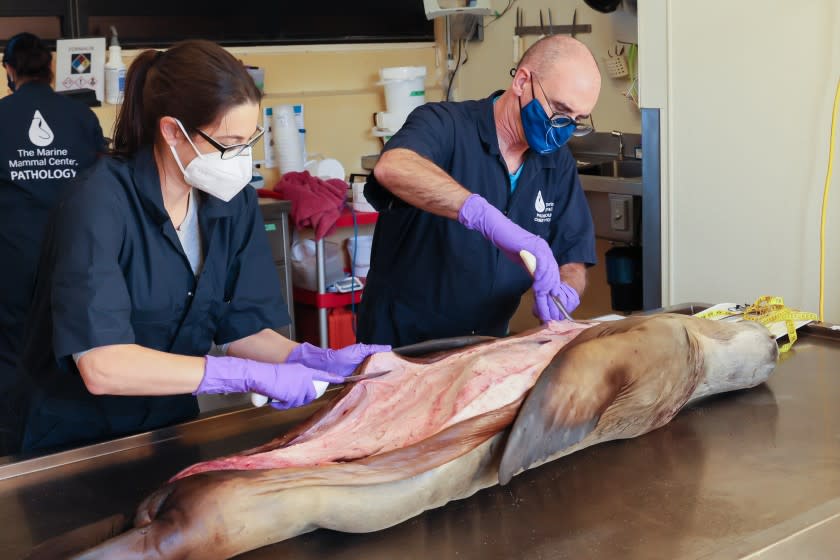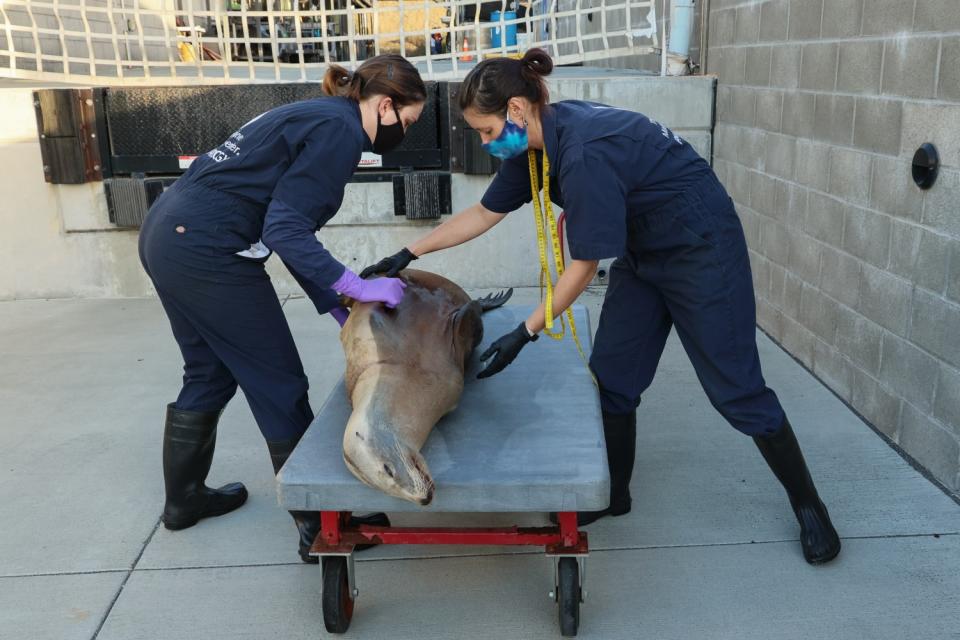Sea lions are dying from a mysterious cancer. The culprits? Herpes and DDT

On a former Cold War missile base perched high above the Golden Gate Bridge, in what is now the largest marine mammal hospital in the world, Frances Gulland still remembers the shock she felt when she first started working here as a veterinarian 26 years ago.
A male sea lion had washed ashore in severe pain. His hind flippers were swollen, his lymph nodes riddled with tumors. Cancer had taken over his kidneys and turned his spine to mush. First responders at the Marine Mammal Center told Gulland they saw this in sea lions all the time.
"Wildlife should not be getting cancer like this, that's crazy!" said Gulland, who was new to California. "How can that be?"
Now, after two decades of study, an all-star team of marine mammal pathologists, virology experts, chemists and geneticists say they’ve connected two surprising culprits: herpes and toxic chemicals, like DDT and PCBs, that poisoned the California coast decades ago.
The ocean is clearly hurting, researchers say, and this mysterious cancer in so many sea lions carries a troubling warning for humans.
"Sea lions, they're coming up on the beach, using the same waters that we swim and surf in, eating a lot of the same seafood that we eat," said Gulland, who has served on the U.S. Marine Mammal Commission since the Obama administration and is now a research associate at UC Davis. "They’re predisposed to cancer by these high levels of legacy compounds that are still in the environment — and we are also exposed to these chemicals."
Marine mammals, like humans, nurse their young and live relatively long lives. Their long-term health is a window into the lasting effects of chronic exposure to the many chemicals humans have introduced to the sea. They accumulate toxins in their blubber and get sick from the same kinds of viruses that affect humans.
So the more we understand how certain environmental conditions can turn a seemingly minor disease into widespread cancer in sea lions, the more we might know how to prevent similar cancers from metastasizing in humans. Is there a way, for example, to prevent cervical cancer — a life-threatening disease that starts with a simple infection of human papillomavirus (HPV) — from proliferating in women?
Scientists in California first noticed the sea lion cancer decades ago, at a time when the ocean seemed too big to fail. Factories were still churning out DDT, a pesticide so powerful that it poisoned birds and fish. Barrels of industrial trash, radioactive materials, oil refinery waste, rotting meats and various acid sludges also got dumped into the sea.
To date, almost 25% of the sea lions that first responders bring to the Marine Mammal Center in Sausalito have died of this one aggressive cancer — among the highest prevalence of a single type of cancer in any mammal, including humans.
Gulland and her team had their suspicions — the nation’s largest DDT manufacturer had dumped its waste not far from the Channel Islands, where many of the sea lions in California breed and feed their pups. There were also signs in their reproductive organs that a sexually transmitted disease might somehow be involved.
But to confirm this, Gulland needed more data — and sea lions, particularly healthy ones, aren’t exactly coming in for doctor’s appointments. So for more than 20 years, she examined every sea lion that she could not save — whether from cancer, a shark bite, net entanglement or brain damage from harmful algal blooms. Her team measured each animal with a standardized set of metrics, ran blood tests and sampled blubber from the same spot over the sternum. They swabbed and dissected immense amounts of healthy tissue, tumorous tissue, reproductive organs and kidneys.

All told, Gulland cataloged 394 sea lions — an unusually comprehensive dataset for such an elusive species. She and a team of scientists adjusted blubber calculations to account for weight loss in sick animals. They systematically ruled out inbreeding and other possible causes.
Patterns emerged. A previously unknown herpes virus was clearly triggering the cancer. The team also confirmed, in a study published recently in the journal Frontiers in Marine Science, that sea lions with higher concentrations of DDT, PCBs and other decades-old chemicals in their blubber were more prone to having the cancer take over their bodies.
"It is extraordinary, the level of pollutants in these animals in California. It is a big factor in why we're seeing this level of cancer," said Dr. Pádraig Duignan, chief pathologist at the Marine Mammal Center and a co-author of the study. He had previously studied sea lions in New Zealand, which have minuscule amounts of DDT compared with what he’s seeing in California.
“With all the dumping since the Second World War, right up to the 1970s, that's a lot of stuff out there,” Duignan said. “These legacy chemicals haven’t broken down anything appreciable in intervening years, and nobody knows if they ever will. This is something that they're going to have to be exposed to for who knows how long.”

Cancer is rare in wild animals. The only similar example of widespread cancer that has been scientifically documented in sea mammals seems to be in a beluga whale population in the St. Lawrence estuary in Canada. The river there had been contaminated by polycyclic aromatic hydrocarbons, or PAHs, produced by local aluminum smelters. Cancer was identified in 27% of the adult whales that were found dead and examined. But after the pollution went down, researchers noted, the cancer went away.
In California, persistent chemicals like DDT remain in the environment, both on the seafloor and working their way back up the food chain in fish and other critters of the sea. Efforts to clean up this mess — a complicated and difficult process — have languished for years.
Eunha Hoh, an environmental health scientist at San Diego State's School of Public Health, was struck by how clearly the sea lion research, which she was not affiliated with, connected cancer to these supposedly historic chemicals. Hoh, too, has continued to find significant amounts of these pollutants in Southern California dolphins and other animals she has studied.
It took more than four decades after these chemicals were banned to prove their connection to the health problems that scientists already suspected, said Hoh, whose work focuses on emerging contaminants in wildlife and humans. So what about all the pesticides, flame retardants and other chemical byproducts still in use today that aren't well regulated or monitored?
Going forward, researchers see the need to collaborate with more human oncologists. Further study of how exactly certain chemicals predispose sea lions to cancer could also inform our understanding of how secondary factors — such as smoking or exposure to pollutants that interfere with our immune systems — push cancer growth in humans, said Dr. Alissa Deming, director of clinical medicine at the Pacific Marine Mammal Center based in Laguna Beach.
Human cancer research tends to rely on mice in more controlled lab environments, said Deming, who, as chair of the Sea Lion Cancer Consortium, has been making sure that the various sea lion research efforts across the globe are working together to build on one another’s work.
"People aren't lab rats, and neither are sea lions — they live their lives, they're exposed to different stressors in the environment and lots of different infectious diseases," she said. "Being able to study them as a model that more truly represents how cancer develops, how cancer spreads, is going to be major."
This story originally appeared in Los Angeles Times.

